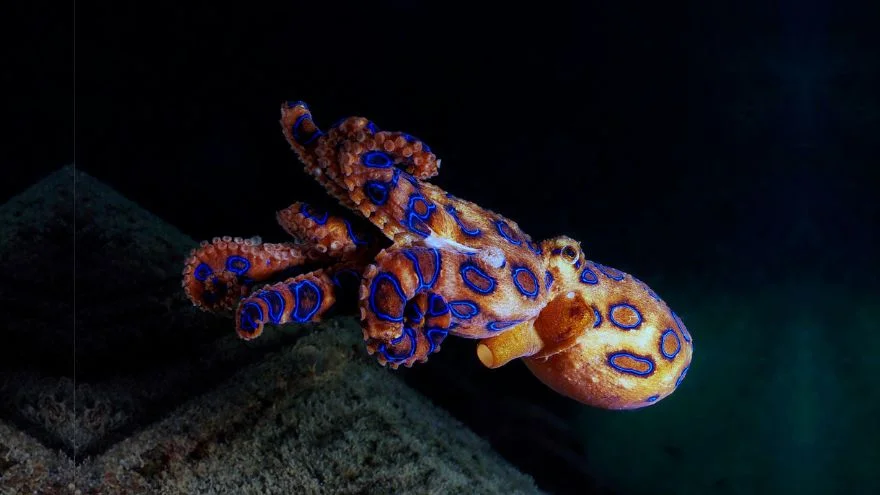Some of the deadliest and most dangerous animals in Bali are capable of causing you great discomfort. From stray dogs, Komodo dragons, venomous snakes, mischievous monkeys, octopuses to parasitic mosquitoes.
Indonesia’s Bali is a popular destination for tourists who thirst for many wonders, of which its wildlife is highly esteemed.
As you take in the satisfying sights of Bali’s pleasures and amusements, be wary of how ravenous some of the creatures that call the island home can be.
Let’s review the animals that present the most threats to humans in Bali and some safety tips you need to know for the wildlife in the area.
What are the Most Dangerous Animals in Bali?
1. Red-necked Keelback
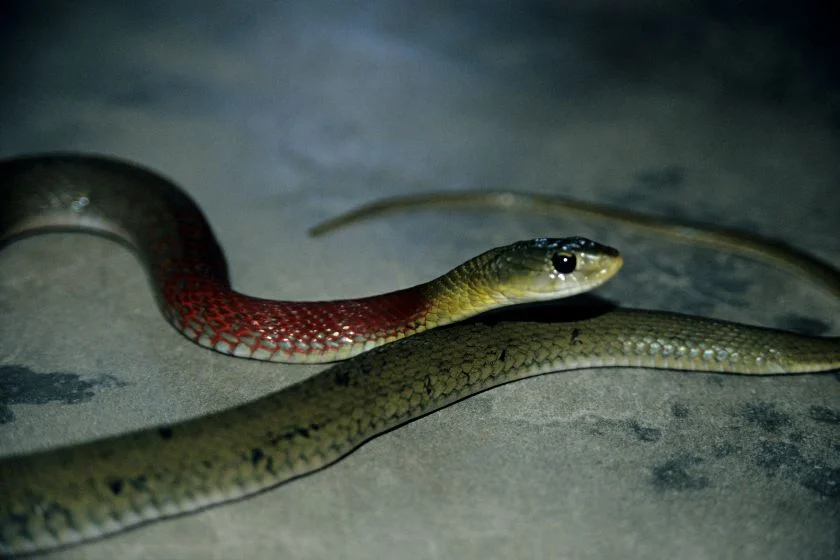
- Scientific Name: Rhabdophis subminiatus
- Classification: Reptiles
- Habitat: Moist forests, marshes, ponds, rice patties
- Diet: Carnivore
- Conservation Status: Least Concern
Once thought to be docile and powerless, the red-necked keelback happens to be one of the most dangerous animals you would find in Bali.
With a length of not more than 3 feet, the venomous snake is one of the most feared rear-fanged snakes with which it releases venom to prey and threats.
The most significant danger posed by the red-necked keelback is the lethal venoms in its rear fang as they bring great discomfort as opposed to bites from its front fangs.
One bite from the red-necked keelback is capable of causing internal hemorrhaging and severe health complications such as disseminated intravascular coagulation, coagulopathy, and nausea.
Little to no health remedy exists for combating the effects of its venom, so it is best you steer clear of its path.
2. Fire Coral
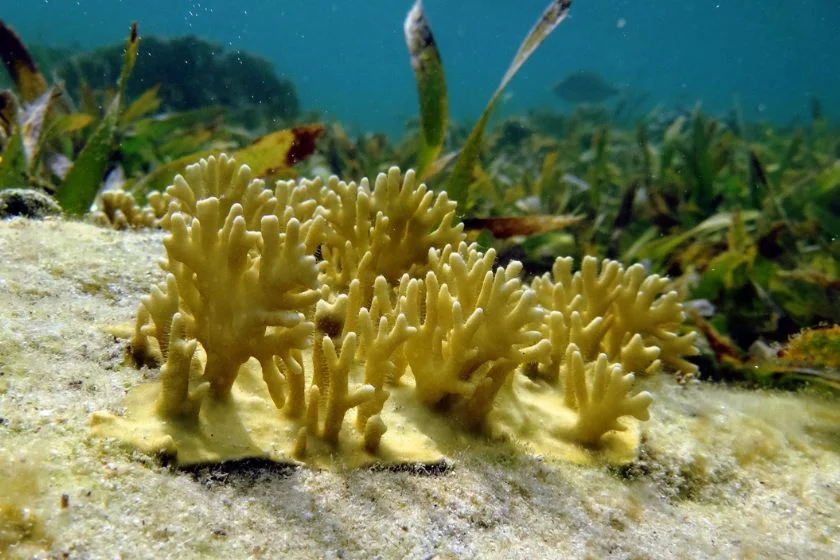
- Scientific Name: Milleporidae
- Classification: Hydrozoa
- Habitat: Shallow reef
- Diet: Carnivore
- Conservation Status: Least Concern
As with fire, you definitely want to stay far away from the fire coral. Though a microorganism, the fire coral can be exceedingly discomforting to anyone unfortunate enough to come close in contact with it.
Do not be fooled by its name. The fire coral has more similarities to underwater creatures such as jellyfish than to corals.
And unlike most animals you would find on our list, the fire coral does not move about for you to encounter unexpectedly. It is located at the bottom of the ocean, on the ocean floor.
Divers and snorkelers are at great risk of feeling the discomfort of the fire coral as they may unintentionally come in contact with it.
A single touch with the fire coral leaves victims with an intense burning sensation lasting at least two days or as long as two weeks.
Other effects of touching the fire coral include urticarial lesions, erythema, fever, and irritation.
This can be attributed to non-lethal venoms found in the fire corals, which are key defensive mechanisms of the microorganisms.
3. Macaques
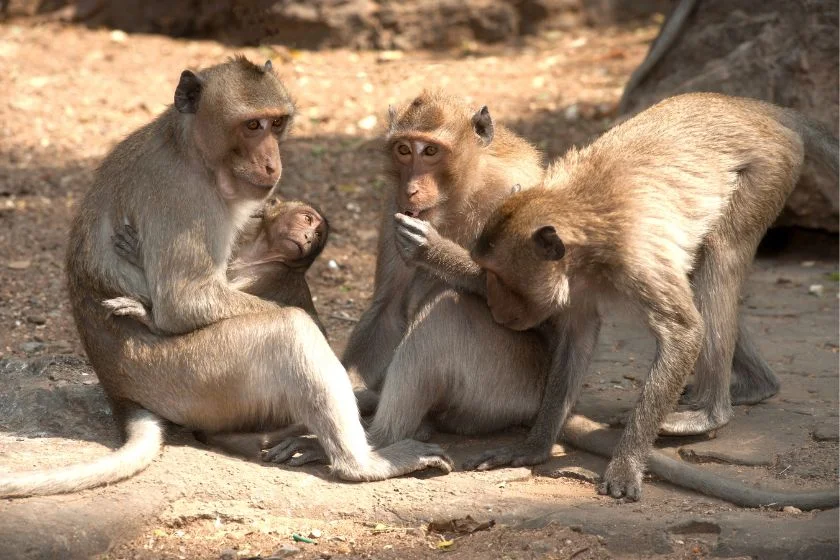
- Scientific Name: Simia inuus
- Classification: Mammal
- Habitat: Tropical rainforest
- Diet: Herbivore
- Conservation Status: Least Concern
The macaques of Bali appear to be more mischievous than dangerous, but these herbivores possess qualities that speak highly of their mischief and danger.
An invasive species that secluded itself in the forests of Bali, you likely would not come across the macaques only on occasions when they flock out into town, and you can be sure they would be on a mischievous rampage.
When they come into human settlements, the goal is to source food; hence, any fruit or food item would beckon their attention.
As with all wildlife, their actions can be unpredictable when searching for food.
They may bite and scratch to steal food. These can present danger as they are host to pathogens that cause great misery to humans if contracted.
A macaque’s bite is one to fear as it can spread deadly viruses and diseases, resulting in great discomfort for all affected.
4. Whitetip Reef Shark
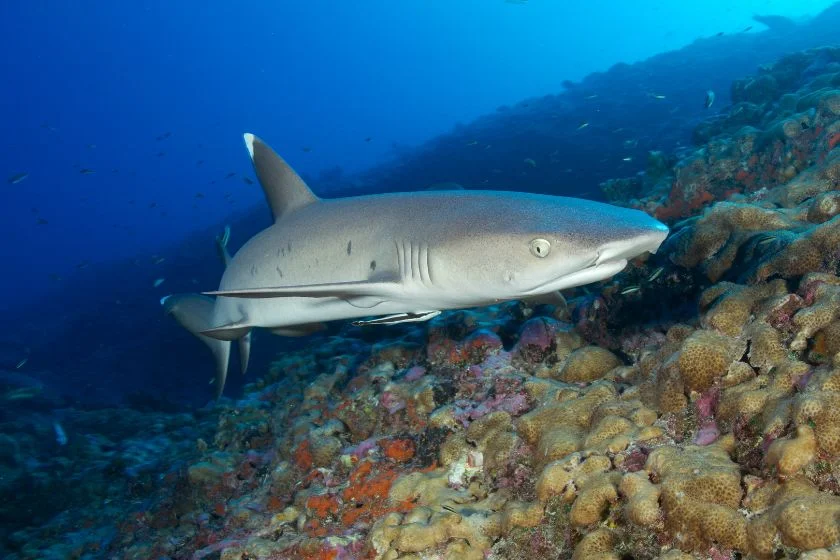
- Scientific Name: Triaenodon obesus
- Classification: Chondrichthyes
- Habitat: Indo-Pacific coral reefs
- Diet: Carnivore
- Conservation Status: Vulnerable
If you plan to dive or snorkel in Bali waters, you should consider this a huge warning. No other animal presents as much risk to you as the whitetip reef shark.
The shark is easy to identify thanks to its slender body and broad head.
They grow as long as 5 feet, hunt in packs, and are often isolated to the ocean floor, places divers and snorkelers love to access.
Unlike most wildlife, the whitetip reef shark has an odd curiosity that makes it fearless.
When it sights divers, rather than move away, it tends to come closer to investigate. The shark, however, is not aggressive to humans but would act violently once provoked.
Sometimes it lays on the ocean floor for hours, so be sure not to collide with or provoke a resting whitetip reef shark.
According to statistics, the whitetip reef shark is credited with only five attacks between 1580 and now.
The attacks are believed to be far more than that, but difficulties in identifying the whitetip reef shark, a member of the requiem sharks, make the figure low.
5. King Cobra
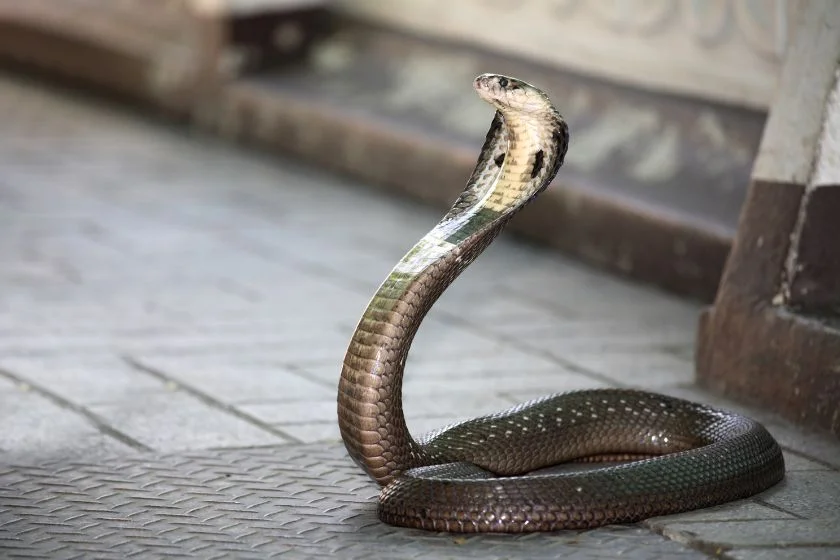
- Scientific Name: Ophiophagus hannah
- Classification: Reptiles
- Habitat: Dense, open forest, bamboo thickets, dense mangrove swamps
- Diet: Carnivore
- Conservation Status: Vulnerable
The king cobra boasts of a great reputation born from its intense aggressive nature and ferociousness.
For snakes, the king cobra boasts an agile movement and can launch long-range strikes that can be fatal and deadly.
Despite how feared it is, the king cobra is one animal that is not receptive to human attention and would shy away once it sights humans.
While it may be shy, it does not shy away from fights. When threatened, it responds to threats with warnings such as hissing, head puffing, and raising its head in an upright position.
This is often followed by a long, sustained bite, long enough to inject its venoms in large quantities and kill its threats.
This thus makes it extremely dangerous as it is brutal and unforgiving when its mind is set on fighting.
6. Mosquitoes
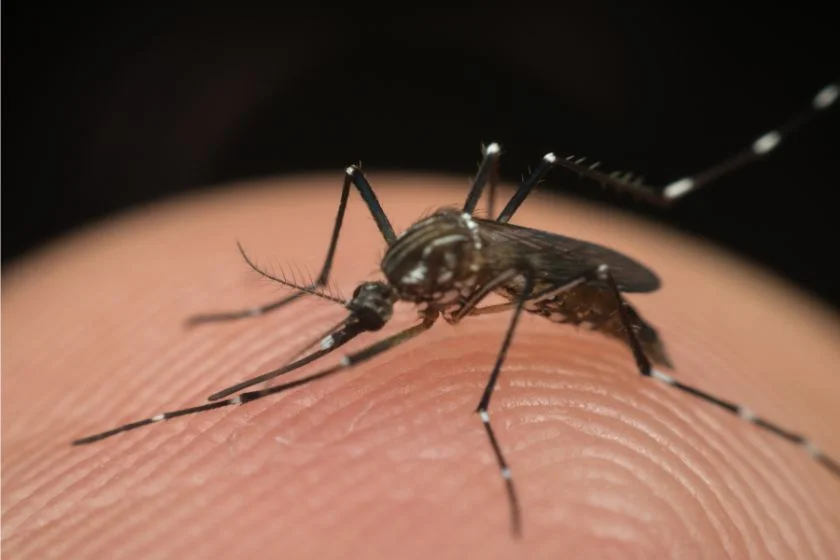
- Scientific Name: Culicidae
- Classification: Insects
- Habitat: Tall grasses, marshes, forest
- Diet: Carnivore
- Conservation Status: Least Concern
One of the most annoying creatures on the planet is mosquitoes.
They may be small and have short lifespans, but the damage done during this period can be fatal and deadly to humans.
In Bali, mosquitoes exist in swarms, and they are unforgiving to humans.
With a single bite and injection of their proboscis into your bloodstream, bacteria, and parasites capable of causing diseases such as malaria, dengue fever, zika virus, and chikungunya are sent in.
These diseases can bring great discomfort and, when not well treated, can lead to death.
The pain accompanying these sicknesses is quite much, and you’d be wise to avoid it.
7. Yellow-lipped Sea Krait
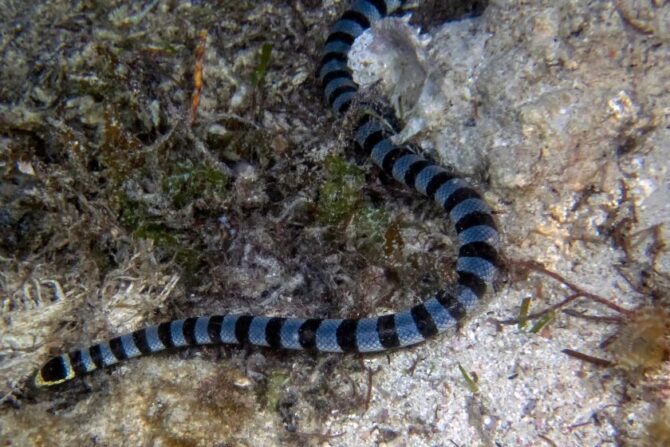
- Scientific Name: Laticauda colubrina
- Classification: Reptiles
- Habitat: Coastal waters, coral islands, coral reefs, mangrove areas
- Diet: Carnivore
- Conservation Status: Least Concerns
Easy to identify with its black stripes and yellow snout, the yellow-lipped sea krait resides primarily on land but goes into the ocean to hunt.
You would mostly come across these reptiles on land, resting, reproducing, or digesting.
But when in the sea, their predatory instinct is in full force, and you’d be wise to avoid crossing its path.
Like most deadly snakes, the yellow-lipped sea krait has venoms toxic to humans, making it quite dangerous.
As deadly as the yellow-lipped sea krait is, it is not aggressive and avoids confrontations with humans.
The snake attacks only when threatened and would strike and release neurotoxins on its victims.
They are excellent swimmers and are deadly on land as they are in the sea.
8. Sea Urchins
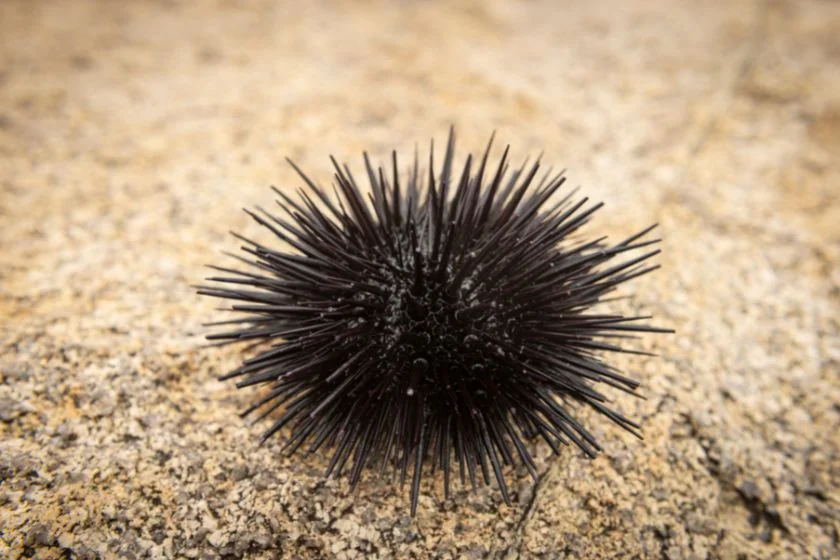
- Scientific Name: Echinoidea
- Classification: Echinoidea
- Habitat: Ocean
- Diet: Herbivore
- Conservation Status: Least Concern
Exclusive to the ocean, sea urchins may not be predatory, but they present as much danger as predatory creatures in the ocean.
Sea urchins blend pretty well with their environment and are not easy to notice.
They thrive well as much as they blend with their environment, but the real danger they present exists in their extremely sharp fins.
Sea urchins possess deadly venoms in their fins, and once they pierce the skin of humans, they release these venoms.
The stings from their fins can cause infections, muscle spasms, abdominal pain, and a burning sensation.
9. Stray Dogs

- Scientific Name: Canis familiaris
- Classification: Mammals
- Habitat: Streets
- Diet: Omnivore
- Conservation Status: Least Concern
One eye sore of Bali street is its exploding stray dog population which can be found on almost every street corner.
These dogs, found on the streets of Bali and sometimes in its forests, are hungry and unkempt. They lack any training and are incredibly desperate.
The struggle for survival for these dogs is arduous. Some of these dogs are adopted by local businesses to safeguard properties, but they get little care and are very aggressive.
These dogs pose dangers to humans as they can be aggressive and, with a single bite, can infect humans with deadly infections and diseases such as rabies.
They tend to be attracted by food, so you would want to rethink leaving food exposed while walking through Bali’s busy streets.
10. Blue-ringed Octopus

- Scientific Name: Hapalochlaena lunulata
- Classification: Cephalopod
- Habitat: Intertidal flats of the ocean
- Diet: Carnivore
- Conservation Status: Least Concern
One look at the blue-ringed octopus, and you may wonder how this tiny creature who seems docile got into our list.
Despite being 8 inches large, they rank among the most dangerous animals in the world.
They thrive in the deep parts of the ocean, and as such, divers and snorkelers are at the most risk of encountering these deadly creatures.
When provoked or threatened, the distinctive blue rings around their bodies change color, and with a single sting, they deliver a lethal neurotoxin known as tetrodotoxin and other deadly toxins.
In a matter of minutes, the toxins from the blue-ringed octopus’ painless stings can lead to death.
The venoms in their stings can cause health complications such as heart failure, nausea, respiratory arrest, and in extreme cases, blindness, and paralysis.
Bali Wildlife Safety Tips
Take note of signs
On beaches and forests in Bali, flags and signs indicating dangers and threats are often erected.
Do take note of these signs and never stray beyond these indications, as you could be treading waters inhabited by dangerous wildlife.
Do not smile at monkeys
Monkeys are common in Bali, and you would want to coexist happily with these animals. One major mistake you should avoid is smiling at monkeys.
Showing your teeth can be misinterpreted as a threat and a sign of aggression by these animals.
Keep food out of sight
The monkeys and stray dogs of Bali will jump at any opportunity to steal food.
Hence, do well to keep food out of sight. This would prevent unwanted attention from dogs and monkeys.
Never dive or swim alone
With the host of deadly creatures habiting Bali’s waters, you cannot afford to swim or dive alone.
Swim with groups and dive with groups as this will prevent wildlife from targeting you as prey, and in cases of emergency, you will have urgent assistance.
Use insect repellent
Bali is home to mosquitoes and other dangerous insects. Do well to use repellents to keep off these insects.
That could be the difference between a peaceful stay in Bali or a chaotic one.
Conclusion
Bali has a lot to offer; beautiful scenery, fascinating wildlife, and many more.
But its wildlife can present a huge challenge to enjoying the pleasures of the island.
Hence do well to be cautious of these most dangerous animals in Bali, as you venture through its wildlife habitats.
Discover The Most Dangerous Animals in Asia:
